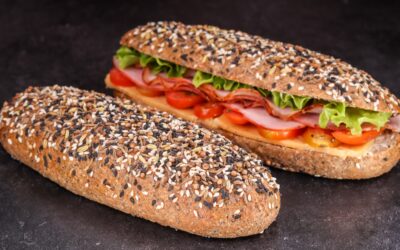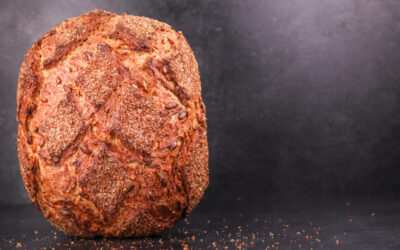This tasty and nutritious five-grain semolina bread is another great addition to this month’s multi grain bread recipe collection.
Durum wheat (of which semolina is milled) has more protein than any other type of wheat – which is good for us. The protein that is specifically required for gluten is not of such high quality in durum wheat as it is in other types of wheat. But we can easily work around that.
You could use durum flour instead of semolina for this recipe and it would make for a smoother dough, but I quite enjoy the texture of semolina in the finished bread. The fennel seed flavour works well with the other ingredients.
Because this dough contains grains like millet, coarse corn meal, and oat bran (which you can swap for wheat bran if you like) we use a technique called ‘soaker’. The purpose of a soaker is to hydrate and soften grains and seeds for breadmaking. There are cold soakers and hot soakers depending on how hard the grains are. You use cold water for a cold soaker and hot (boiling) water for a hot soaker. In this recipe the soaker is hot because the millet is relatively hard.
Soakers can be made many hours before use. But as little as 45 minutes is enough for this recipe. If you were going to leave a soaker overnight, then bear in mind that if the kitchen is warm the soaker may start going off due to enzymatic activity. In such a situation it is advisable to use some or all the salt of the bread recipe in the soaker to prevent it from spoiling.
This is a cold proofed dough which makes it slightly more acidic and gives it a more pronounced and distinct taste. You can of course bake it on the same day if you like. Simply leave for 2-hour bulk proof with one fold in between, then shape, proof, and bake.
You can shape this loaf how ever you like. You can make it free-standing, or you can proof and bake it in a tin, or even make small rolls.
I chose a round shape this time because I wanted to try out this ‘scoring’ technique. We all know scoring a loaf is important to make it rise in a controlled way and expand out of weak points determined by us. If the bread is not scored it bursts open at its weakest point which is normally the seams at the bottom.
Usually, a loaf is shaped and then placed in a bread basket with the smooth (top) side down. When it is inverted for baking the smooth side is once again on top. Then the bread is scored and baked.
The technique I demonstrate works in the opposite way. The loaf is placed in the basket with the smooth side pointing up. Once inverted for baking the seams are pointing up. The bread is not scored and left to purposely rise and expand out of those seams resulting in a unique design and less work for us. Have you ever tried this?
Watch the video down below for detailed instructions.
Ingredients
For the soaker –
40g (1.4oz) millet
40g (1.4oz) oat bran or wheat bran
20g (0.7oz) coarse corn meal
7g (0.25oz) fennel seeds
130g (4.6oz) boiling water
For the main dough –
270g (9.5oz) semolina or durum wheat flour
180g (6.4oz) white bread flour
10g (0.35oz) salt
5g (0.17oz) instant dry yeast or 6g (0.21oz) active dry yeast or 15g (0.52oz) fresh yeast
240g (8.5oz) cold water *
*To learn more about dough temperature control click here.
Method
- Make the soaker. In a large bowl combine the millet, oat bran, corn meal, fennel seeds, and the boiling water. Stir well. Cover and leave to soak and to cool down for 45 minutes.
- Add the remaining water, yeast, and salt. Mix well to dissolve the salt and hydrate the yeast. Add the white bread flour and the semolina. Mix to a dough.
- Tip the dough out on the table and leave to rest for 15 minutes. This will let the semolina absorb water and make it easier for us to knead the dough.
- Knead for 6 minutes. *Desired dough temperature 23C – 24C (73F – 75F).
- Cover and refrigerate the dough for 1 hour.
- Fold. This step will help with cooling the dough quicker.
- Cold proof for 12 – 18 hours.
- Shape the loaf and place it in a bread basket with the smooth side pointing up.
- Final proof should take 3 – 4 hours depending on the temperature of your kitchen. Mine was at 22C (72F) and it took 4 hours. *During the final hour of proofing preheat your oven and baking vessel to 210C (410F) fan off.
- Bake the loaf for 20 minutes with the lid on.
- Remove the lid and bake for another 20 minutes.
Cool down and enjoy! Check out some more multi grain loaves on my channel. Cheers!
Keep in mind that the conditions in each kitchen are different, so fermentation times may vary for you. It is up to the baker to control the bread and react accordingly.
Your oven may be different too, so your baking time may vary.
Watch the video here



